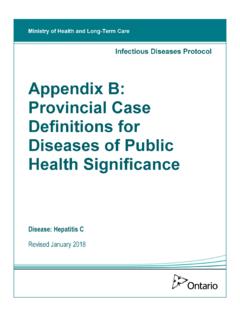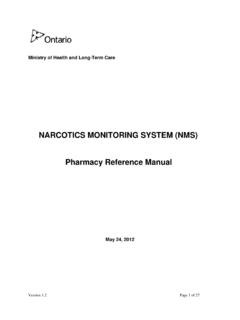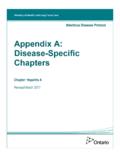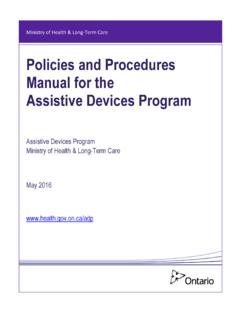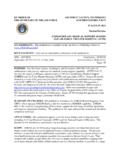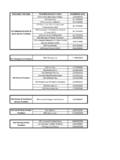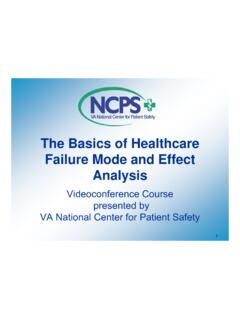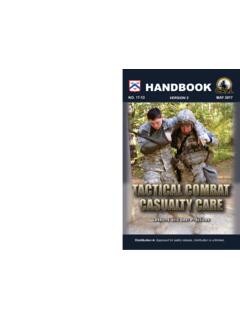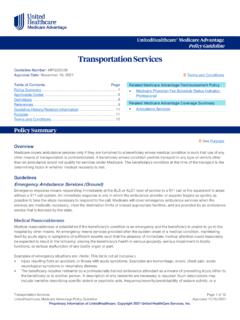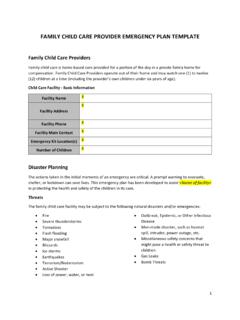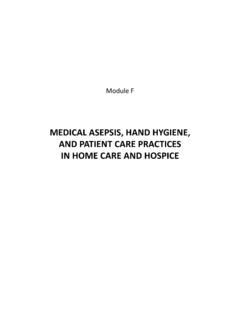Transcription of Vaccine Storage and Handling Guidelines - Ontario
1 Vaccine Storage and Handling GuidelinesIntroductionImmunizations help save lives, prevent serious illnesses, and are recognized as one of the most effective public health interventions available today. Immunization programs are among the most cost-effective ways to prevent disease. The success of these programs depends heavily upon the high immunization coverage of the target group and Vaccine inventory management, including proper Storage and Handling of vaccines. By understanding and implementing proper Vaccine Storage and Handling practices, staff in health care provider premises can play a critical role in improving the health of Ontarians by ensuring that the administered vaccines retain their potency and that Vaccine wastage is document is intended to assist all health care providers with how to properly store and handle provincially funded vaccines.
2 Prior to storing Vaccine , health care providers are required to understand and meet with the Vaccine Storage and Handling requirements indicated in this document. Glossary ..3 Public Health of the Cold Chain ..5 Staff Designated to Monitor Vaccine Storage and Handling Practices in the Premises ..6 Refrigerators Used for Vaccine Monitoring Devices ..8 Digital Maximum-Minimum Thermometers ..9 Data Loggers ..9 Vaccine Storage and Handling Practices ..10 Insulated Containers ..14 Contingency Planning ..18 Electricity disruptions (localized or general) ..18 What to do when the temperature is below +2 C and/or above +8 C ..20 Inadvertent Administration of Exposed and/or Expired Vaccine .
3 21 Public Health Units in Ontario ..223 GlossaryCold chainThe cold chain includes all of the materials, equipment and procedures used to maintain vaccines in the required temperature range of +2 C to +8 C from the time of manufacture until the vaccines are administered to chain incidentOccurs when Vaccine is exposed to a temperature outside the required temperature range of +2 C to +8 C for any period of time and the potency of the Vaccine is potentially chain incident inspectionCold chain incident inspections investigate the cause of the cold chain incident, determine whether Vaccine can be used by the health care provider or returned to the public health unit, provide follow-up education in order to prevent the occurrence of future incidents and ensure that adequate cold chain conditions can be maintained prior to continuing the Vaccine supply to the health care vaccineVaccine that is stored or handled at temperatures below +2 C and/or above +8 C for any period of time, or that is not stored according to the manufacturer s recommendations is considered to be exposed.
4 Depending on the length and type of exposure some vaccines may still be viable. Contacting your public health unit will assist you in determining what Vaccine is still considered container An insulated container is a solid walled container with a tight lid. The container must be able to store and transport vaccines at the required temperatures for the necessary duration of (annual) inspectionRoutine inspections assess the health care providers level of compliance with Vaccine Storage and Handling requirements, including cold chain requirements. Routine inspections enable public health unit staff to provide information and resources regarding the proper Storage and Handling of vaccines and the proper temperature monitoring device that should be in place to optimize Vaccine potency.
5 Spoiled Vaccine Spoiled Vaccine is Vaccine that cannot be used because of exposure to temperatures below +2 C and/or above +8 C for a specific period of time. This will depend on the specific Vaccine . The public health unit assesses all provincially funded vaccines that have been exposed to determine whether they can be monitoring deviceAn electronic device that measures temperatures. This can include devices such as a digital maximum-minimum thermometer, data logger or a chart recorder. Vaccine Cold Chain Incident Exposure/ Wastage Report formThis report form is used by public health units to document when provincially funded vaccines are exposed to a cold chain incident. This report provides details of the incident and the vaccines that were wasted and/or exposed during the cold chain incident.
6 This form (#4574-64) is available on the Ontario Central Forms Repository at Vaccine Cold Chain Maintenance Inspection Report formThis report form is used by public health units when conducting routine (annual) inspections. This form assesses a health care provider s compliance with all Vaccine Storage and Handling requirements. This form (#4575-64) is available on the Ontario Central Forms Repository at Wasted vaccineAny Vaccine that cannot be used is considered to be wasted. This includes vaccines that are spoiled and those that have Health Units Recent inspections of refrigerators in health care provider premises have shown that improper Storage and Handling of vaccines is still a significant problem in Ontario .
7 Public health units are required by the Vaccine Storage and Handling Protocol under the Ontario Public Health Standards, issued under the authority of the Health Protection and Promotion Act to respond to reports of all cold chain incidents and to inspect premises, at least once annually, where provincially funded vaccines are stored. The purpose of cold chain incident and routine (annual) inspections is to: Ensure the proper management of Vaccine inventories; Provide education strategies to minimize Vaccine wastage; Reduce provincially funded Vaccine wastage; and Promote Vaccine safety and effectiveness. Public health units must conduct cold chain incident and annual routine your public health unit for assistance with Vaccine Storage and Handling practices.
8 5 Importance of the Cold Chain Vaccines are sensitive biological substances that can lose their potency and effectiveness if they are exposed to temperatures (heat and/or cold) outside the required temperature range of +2 C to +8 C or when exposed to light. Freezing refers to a situation where vaccines experience temperatures at or below 0 C. Vaccines may not appear frozen but may have been damaged at these temperatures. Most vaccines are considered to be damaged at 0 C. Failure to adhere to cold chain requirements may reduce Vaccine potency, resulting in lack of protection against Vaccine preventable diseases and/or increased local reactions after administration of Vaccine .
9 The loss of Vaccine effectiveness due to cold chain exposures to adverse conditions is cumulative, permanent and irreversible. Individuals who are immunized with exposed vaccines often need to be recalled by their health care provider and reimmunized to ensure that they are protected against the specific Vaccine preventable disease(s). Vaccines may be wasted if they have been exposed to temperatures below +2 C and/or above +8 C or if they are not used prior to the expiry date. Vaccine wastage results in increased costs (to replace the wasted vaccines, human services and specialized transportation). With the globalization of the Vaccine manufacturing industry, and intermittent global Vaccine shortages, it is not always possible for Ontario to quickly obtain additional quantities of vaccines to replace Vaccine that is , tetanus and acellular pertussis Vaccine affected by freezing showing large conglomerates of massed precipitates with crystalline structureVaccine stored between +2 C to +8 CVaccine stored at -18 CWorld Health Organization, Department of Immunization, Vaccines, Biologicals.
10 Temperature sensitivity of vaccines. Geneva, Switzerland: World Health Organization; must be stored and transported within the required temperature range of +2 C to +8 C at all vaccines are considered to be damaged at 0 C. Frozen or damaged Vaccine may not visually appear solid or change in to adhere to cold chain requirements may reduce Vaccine potency, resulting in lack of protection against Vaccine preventable diseases and/or increased local reactions after administration of loss of Vaccine effectiveness due to exposures to adverse conditions is cumulative, permanent and irreversible. 6 Staff Designated to Monitor Vaccine Storage and Handling Practices in the Premises Staff Handling provincially funded vaccines require knowledge of: The importance of the cold chain; Vaccine Storage and Handling practices; Equipment maintenance and repair procedures; The appropriate action to be taken in the event of a Vaccine exposure; and Contingency plans and ensure that they are in place in the event of premises closure during staff vacation, equipment failure and/or electrical disruptions.

